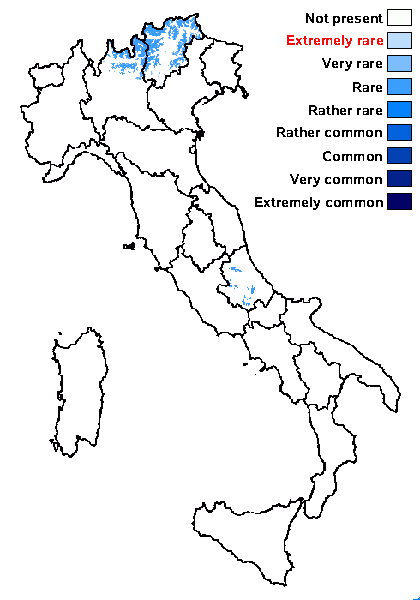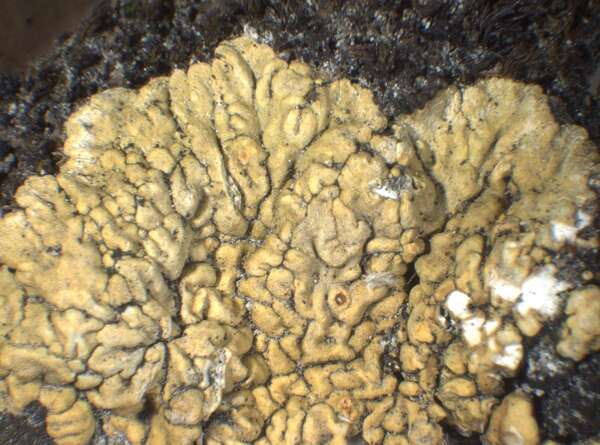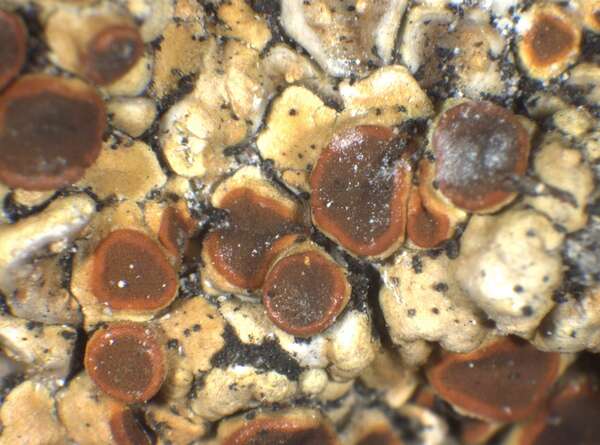Gyalolechia pruinosa Körb.
Ver. zool.-bot. Ges. Wien, 17: 703, 1867.
Synonyms: Caloplaca aurea f. rupicola (Arnold) Zahlbr.; Caloplaca pruinosa (Körb.) Zahlbr.; Candelariopsis pruinosa (Körb.) Szatala; Fulgensia pruinosa (Körb.) Poelt; Fulgensia pruinosa var. fissiseda Poelt
Distribution: N - TAA, Lomb. C - Abr.
Description: Thallus crustose-placodioid, episubstratic, whitish yellow to orange-yellow, white-pruinose in central parts, forming 1-2 cm wide rosettes. Areoles 1-2(-3) mm broad, flattened, contiguous, the marginal ones distinctly elongate, forming 2-3 mm wide, radiating, contiguous lobes, anchored to thin layers of soil in rock fissures by rhizine-like bundles of hyphae. Apothecia frequent, numerous, zeorine, rounded, sessile, 0.5-1(-2) mm across, with a reddish orange to brownish orange, flat, rugose disc and a thin, orange-yellow, pruinose margin. Epithecium brownish orange, K+ purple-red; hymenium colourless, 70-80 μm high; hypothecium colourless. Asci 8-spored, clavate, functionally unitunicate, apically thickened with a broad internal beak, the inner part of apex and external cap I+ blue, Teloschistes-type. Ascospores 1-septate, hyaline, fusiform, thin-walled, 18-27(-30) x 5-8 μm, often slightly constricted at septum. Pycnidia orange-yellow, immersed. Conidia narrowly ellipsoid. Photobiont chlorococcoid. Spot tests: thallus and apothecia K+ purple-red, C-, KC-, P-, UV+ pale orange. Chemistry: fragilin dominant, with smaller amounts of emodin and parietin.Note: on steeply inclined to rain-sheltered surfaces of calcareous rocks, mostly in fissures, sometimes on epilithic bryophytes, with optimum above treeline; var. fissiseda Poelt grows on the top of birds' perching boulders.
Growth form: Crustose
Substrata: rocks
Photobiont: green algae other than Trentepohlia
Reproductive strategy: mainly sexual
In underhangs rarely wetted by rain
Commonnes-rarity: (info)
Alpine belt: rare
Subalpine belt: very rare
Oromediterranean belt: absent
Montane belt: absent
Submediterranean belt: absent
Padanian area: absent
Humid submediterranean belt: absent
Humid mediterranean belt: absent
Dry mediterranean belt: absent

Predictive model
Growth form: Crustose
Substrata: rocks
Photobiont: green algae other than Trentepohlia
Reproductive strategy: mainly sexual
In underhangs rarely wetted by rain
Commonnes-rarity: (info)
Alpine belt: rare
Subalpine belt: very rare
Oromediterranean belt: absent
Montane belt: absent
Submediterranean belt: absent
Padanian area: absent
Humid submediterranean belt: absent
Humid mediterranean belt: absent
Dry mediterranean belt: absent

Predictive model
 INDEX FUNGORUM
INDEX FUNGORUM
 GBIF
GBIF
 DOLICHENS
DOLICHENS




